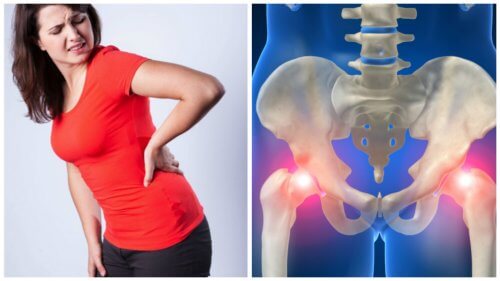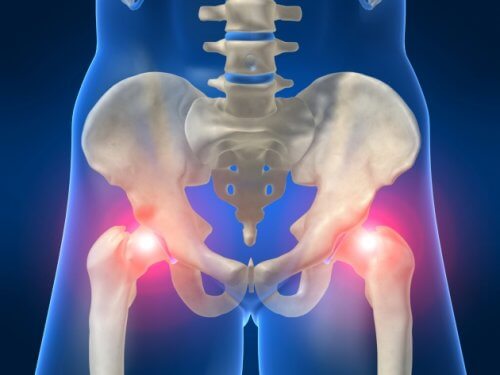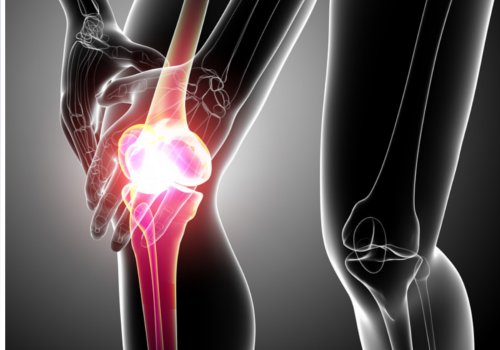6 Possible Causes of Recurring Hip Pain

Although recurring hip pain may be caused by more serious conditions that require medical attention, bad posture or overexertion can also cause it.
Believe it or not, hip pain is one of the most common reasons people go see a doctor, especially people 60 and older. Although hip pain affects people in all stages of life, adults typically suffer from recurring hip pain.
This condition is characterized by an intense pain in the joints surrounding the hip. In addition, it’s almost always accompanied by a feeling of heaviness that can make movement difficult.

Sometimes the symptoms extend as far as the abdomen and lower back. This may make it impossible to complete everyday tasks.
Inflammatory illnesses, traumas, and the breakdown of the joints are the main factors associated with hip pain.
However, since many people don’t understand its triggers and causes, we’d like to take a look at some of the most common ones.
Causes of recurring hip pain
1. Bad posture
Bad posture when it comes to both walking and sitting is one of the most common causes of hip pain.
This pain is the result of staying in one position for an extended amount of time. As you can imagine, this affects the muscles and joints.
The shape of certain kinds of chairs, wearing high heels, or doing certain kinds of physical activity may also have a strong impact.
2. Hip bursitis
Bursitis is an inflammatory condition characterized by swelling in the small liquid-filled sacs that cushion the bones, muscles, and tendons. Bursae are small sacs located around major joints like the knee, shoulders, and hip.
Bursae are in charge of reducing friction during joint movement. Since they’re regularly exposed to trauma, they usually play a part in recurring hip pain.
3. Osteoarthritis

Osteoarthritis is a condition characterized by bone and joint inflammation. It’s the result of the gradual deterioration of the cartilage that protects them from friction. This condition can develop in any joint. However, it frequently affects the hands, knees, and hips.
Symptoms appear progressively. Even though they can be controlled with various medications, there’s no absolute cure.
When osteoarthritis affects the hip, it does so in the anterior joints and groin. This triggers inflammation and pain that vary in intensity.
4. Hip fractures
Hip fractures are medical emergencies that require immediate medical attention. This is because they have complications that can permanently affect mobility and, in extreme cases, can be life-threatening.
The risk of suffering a hip fracture increases with age. This is because the skeletal system gradually loses density due to the body’s increasing difficulty to absorb nutrients.
Even so, it can happen earlier in life as well. This may be because of the development of a chronic condition or due to some type of trauma.
5. Tendonitis

Tendonitis is the inflammation of the tendons that connect muscle to bone. This can happen in any tendon of body. However, it’s most common in the elbows, knees, and hips.
Athletes are usually the most affected, as well as those whose work requires a high level of physical exertion. However, it may also be a response to a trauma or disease.
When there’s tendonitis in the hip area, it’s known as tendonitis of the iliac muscle. This type of tendonitis sometimes causes an uncomfortable pop along with pain during certain movements.
Check out this article: How to Treat Tendonitis
6. Sciatica
Sciatica is caused by irritation or inflammation in the sciatic nerve. This is the biggest nerve in the entire body. When it’s injured, it causes pain from the lower back to the hip and back of the leg.
Sciatica is not considered a disorder per se since it actually tends to be a symptom of underlying medical conditions. These may include a herniated disk, spinal stenosis, or degenerative disk disease.
Along with hip pain, sciatica causes a tingling sensation in the lower limbs. However, rest, pain relievers, and some stretching exercises can speed up recovery.
Overall, the cause of recurring hip pain varies case by case. It doesn’t always mean there’s a serious problem. It’s very important to seek medical attention and physical therapy, especially when the pain is recurring.
All cited sources were thoroughly reviewed by our team to ensure their quality, reliability, currency, and validity. The bibliography of this article was considered reliable and of academic or scientific accuracy.
- Enseki, K., Harris-Hayes, M., White, D. M., Cibulka, M. T., Woehrle, J., Fagerson, T. L., … Torburn, L. (2014). Nonarthritic Hip Joint Pain. Journal of Orthopaedic & Sports Physical Therapy. https://doi.org/10.2519/jospt.2014.0302
- Souza, R. B., & Powers, C. M. (2009). Differences in Hip Kinematics, Muscle Strength, and Muscle Activation Between Subjects With and Without Patellofemoral Pain. Journal of Orthopaedic & Sports Physical Therapy. https://doi.org/10.2519/jospt.2009.2885
- STANISH, W. D., RUBINOVICH, R. M., & CURWIN, S. (1986). Eccentric Exercise in Chronic Tendinitis. Clinical Orthopaedics and Related Research. https://doi.org/10.1097/00003086-198607000-00014
- Lavalle Montalvo, C. (2010). Osteoartritis. Rrevista Medica UNAM. https://doi.org/10.4067/S0370-41061981000500001
This text is provided for informational purposes only and does not replace consultation with a professional. If in doubt, consult your specialist.








